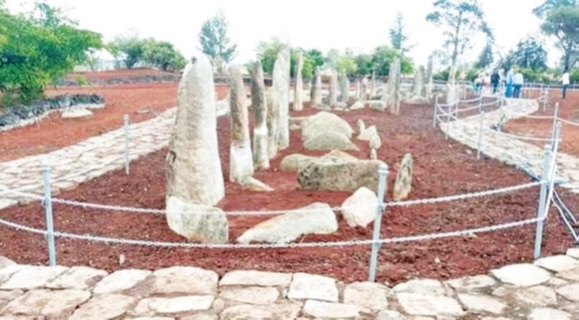
BY STAFF REPORTER
Tiya is among the most important 160 archaeological sites discovered so far in the Soddo Woreda, south of Addis Ababa. The site contains 36 monuments, including 32 carved stelae covered with symbols, most of which are difficult to decipher.
Archeological excavations show that the site contains graves and the stelae have cravings representing swords and various enigmatic signs quite unlike those of other regions. The tradition of erecting megalithic monuments is very ancient in Ethiopia.
As David J. Patten, a writer, travel photographer, and graphic artist wrote, thirty-six huge stone monoliths, 32 of which bear strange carvings of swords and other signs and symbols, stand clustered in the tall grasses of a large field less than a kilometer outside the small town of Tiya.
This stelae show a sword, circles, a zigzag symbol and the “false banana tree” carving typical of the Tiya stelae. The carvings on the stelae have, for the most part, not yet been deciphered. The largest stela rises to an impressive height of five meters (over 16 feet).
Excavations by French and Ethiopian archaeologists have unearthed stone artifacts as well as skeletons of humans who likely were between 18 and 30 years in age when they died. The stelae appear to mark mass graves that may be those of warriors. Carbon testing has dated the remains to the 12th to 14th centuries.
However, who created the stelae and what their purpose might have been, aside from marking graves, is still unknown.
As to him, the most common carvings on the stelae are swords, each of which may indicate the number of people buried at the site or the number of people killed by the warrior buried there.
Some carvings appear to be schematic representations of humans. Carved circles are thought to represent female breasts; other carvings are thought to be human body parts or tools.
One of the most common motifs is the so-called “false banana tree” or “fountain-like” shape, which recalls the semicircular forms found topping the stelae at Axum.
Another visitor also wrote in article titled ‘Language of the Megalithic Tiya’ owing to its long tradition of erecting monuments, Ethiopia is regarded as a land of {megaliths}. The varieties of [monuments comprised within the Ethiopian megalithic culture fall into three major groups: dolmens, tumuli and stelae of which the latter can be further subdivided in two groups, in terms of their occurrence. Whereas, the first group of stelae appears in the north of the country, mainly in Tigray State, Ethiopia’s southern part is renowned for a huge number of particular megalithic sites, containing the so-called stones of Gragn (Ye Gragn Dingay)
However due to the reasons believed to have been caused by the landscape and the type of soil, Tiya monuments were experiencing cracking and tilting problems.
To end this, and at the same time preserve and pass on the historic and cultural value of the heritages to the next generation, the government has recently carried out renovation activities in the areas in a manner it align with their original appearance.
As to Adane Tessema, Culture, Tourism and Sport Burea of Soddo Woreda, apart from the erecting monuments in Tiya, there are over 100 stelae in Soddo Woreda. If it is possible to collect and develop them, they can generate substantial economic benefits.
Mentioning the efforts made to pass on erecting megalithic monuments of Tiya to the next generation, he said however, in earlier years the site did not receive the attention it deserves at the needed level from concerned bodies, FBC reported.
In 2020, with a budget of three million birr an activity had been started to repair and restore the museum along with the heritages kept in it. However, it was made discontinued following the outbreak of Coronavirus. Currently, the interrupted work has been restarted at a cost of 1.8 million Birr in collaboration with the Federal Ministry of Culture and Tourism and the Authority for Research and Conservation of Cultural Heritage (ARCCH). The renovation work was funded by (ARCCH).
According to him, removal of acidic soil, that has a potential to damage the heritages, is conducted and replaced with the suitable once to prevent the monuments from being damaged. Other similar works, such as reparation, drainage construction, beautification, have been carried out.
Tiya erecting monuments is though located in a close proximity to the capital Addis Ababa and inscribed by UNESCO as one of world heritages; the number of its visitors is minimal due to poor promotion works. More advertising works should be carried out to promote the site and gain the required benefit, he added.
He also thanked the local community for preserving the heritages, and called on to continue the work in more concerted manner than ever.
Commending the development activity conducted in the area, local people said that although the monuments have been registered under the list of UNESCO 40 years ago, the spot has not been developed well. The recent action of the government is appreciable as the restoration and conservation activities would secure the monuments from damage, as FBC reported.
The renovation plan of Tiya Monument is one of government’s plans to renovate the four of Ethiopia’s World Heritage Sites – the Rock-Hewn Churches of Lalibela, the Aksum Obelisk, Fasil Ghebbi in Gondar and the Tiya stelae.
The stelae were designated as UNESCO World Cultural Heritage Site in 1980.
The Ethiopian Herald April 3/2021





Создание и продвижение сайтов в Москве – https://savers.top. Полный спектр работ с сайтами. Контекстная и таргетированная реклама для продвижения сайта и социальных сетей в интернете. Реклама для вашего интернет-магазина. Чат-боты для бизнеса в Telegram и WhatsApp.